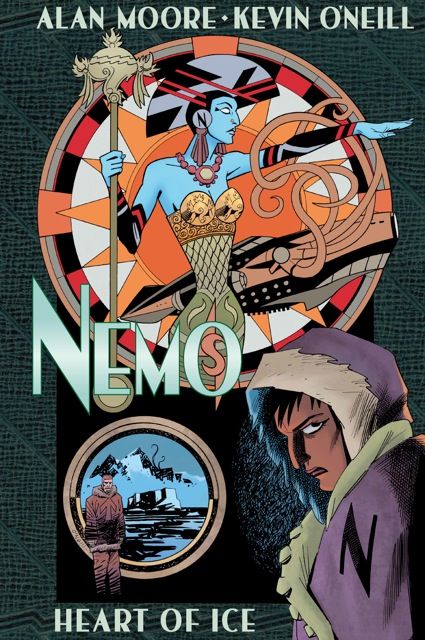"Nemo: Heart of Ice," the latest installment in Alan Moore and Kevin O'Neill's "League of Extraordinary Gentlemen" series, is not a proper League tale. Set in 1925, it focuses on Janni Dakkar, daughter of Captain Nemo, and the pirate crew of her submarine Nautilus. Bored of pillaging and weighed down by her dead father's legacy, Janni determines to prove herself by recreating Nemo's ill-fated expedition to Antarctica. The resulting graphic novel sees Moore and O'Neill pull out all the stops as the characters encounter some of the greatest creations of H.P. Lovecraft, Edgar Allen Poe, and Jules Verne.
On the surface, "Heart of Ice" reads as a lighter tale than most League works. The trademark nods to obscure genre fiction are here, promising to send all but the most obsessive reader scurrying to Wikipedia to unravel throwaway jokes, but the complex plotting of works like "The Black Dossier" and "Century" is missing. In its place we have a fairly standard adventure framework, but -- perhaps unsurprisingly from Moore and O'Neill -- there's more to "Heart of Ice" than meets the eye.
Like Joseph Conrad's "Heart of Darkness," "Heart of Ice" uses a simple journey narrative to reflect various personal and social themes. As she travels the deadly Antarctic ice seeking an adventure worthy of her father, Janni learns the difference between hearing an exciting story and actually living it. As well, Janni believes she lives in the twilight of a great age of scientific advancement, and it's no accident that this coincides with humanity's exposure to the terrifying mysteries of Lovecraft's universe: mankind seems much smaller and punier in "Heart of Ice" than in previous League tales of colorful pulp heroes overcoming bizarre adversaries.
The chance to see Alan Moore finally give the Lovecraft mythos a proper handling is one of the big draws of "Heart of Ice." One of the sections of "The Black Dossier" sees the P.G. Wodehouse characters Jeeves and Wooster face an incursion into their reality of one of Lovecraft's Great Old Ones, but it's only a short story, and played with ironic humor. Happily, "Heart of Ice" delves deep into the lore set out in Lovecraft's "At the Mountains of Madness," and Moore pulls out all the stops to capture the cosmic horror of Lovecraft's work. There's a wonderfully confusing sequence in which Janni and her crew are trapped in an area of fragmented time, and the elements taken from Poe and Verne are weaved in so cleanly that they seem a natural part of Lovecraft's concept.
Kevin O'Neill meets the high bar set by his previous "League" art, capturing as always the series' old-fashioned pulp feel and obsessive attention to detail. He's also well suited to depictions of cosmic monstrosities, and his huge albino penguins, ghostly apparitions and amorphous shoggoth are, frankly, terrifying. Some of his figures are a bit stiff, but in a comic not really focused on action, this is forgivable. O'Neill also spills plenty of black ink on moody shadows and chilly nightscapes, but when color is called for, Ben Dimagmaliw ably steps up to the task, no matter how psychedelic.
"Nemo: Heart of Ice" meets every goal it sets for itself. It's a fun adventure story supported by a complex thematic weave. It truly does justice to the source material from which it draws, and to which it pays loving homage. In classic Alan Moore style, there are a few extras before and after the main story, and they give a nice depth to the characters while setting up possible plots for another "League of Extraordinary Gentlemen" tale or two. As long as Moore and O'Neill keep working at the level of "Nemo: Heart of Ice," stories of the League will be well worth reading.

